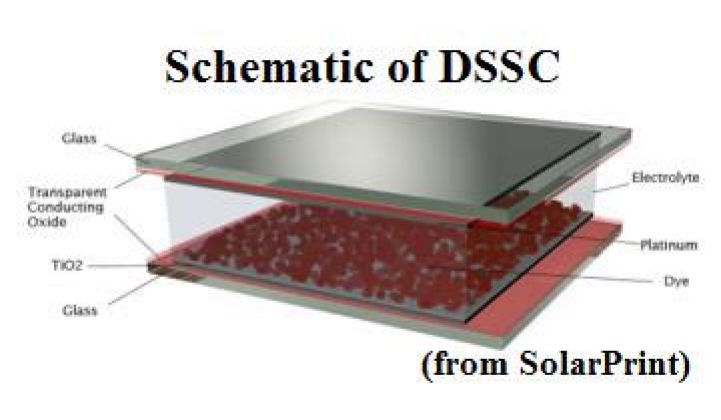“When you are travelling around the world,” said Mazhar Bari, CEO and co-founder of SolarPrint, “you suddenly realize, ‘Where are the bloody solar panels?’”
That question led Bari, an Irish citizen with Pakistani roots and a physics degree from Cambridge, to explore dye sensitized solar cell (DSSC) technology. DSSC is “part printable, part liquid,” he said. Potentially, DSSC could be less expensive than traditional solar cells -- and hence more ubiquitous -- if the manufacturing and technological nuances could be mastered.
SolarPrint effectively has eliminated the liquid part of DSSC and replaced it with nanomaterials and printing. This means that all of the active elements of SolarPrint's cells, not just part of them, are applied through printing.
“There are many components in the cell. One layer is called the electrolyte layer.” As a liquid, that layer is “terrible,” Bari said. The efficiencies are adequate, he said, but “lab time is crap and it cannibalizes the materials in the cell.” The SolarPrint process replaces that liquid with a printable electrolyte paste made of smart nanomaterials, carbon nanotubes, graphene and ionic salts. “And it’s a fully printable device.”
Roy Horgan, Business Development Director and co-founder, argues that this reduces the company's cost to less than a quarter of those associated with traditional processes.
That said, dye-sensitized solar cells remain a tricky technology. Others have tried and come up short. Mass manufacturing is not easy. Worse, the cells tend to break down over time. Since consumers buy solar cells to last for 30 years, reliability is a big issue.
Bari, Horgan and their team believe that SolarPrint’s unique way into the marketplace will be through their technology’s ability to capture low or diffuse light levels both indoors and under overcast, early morning and late evening outdoor conditions. “Dye solar cells work very well indoors,” Bari said. “The voltage doesn’t drop like crazy (like silicon) and it is able to produce reasonable power in indoor light -- four or five times higher than silicon.”
The SolarPrint cells are more efficient because they are based on a rounded nanotech structure instead of the angular crystalline structure of silicon materials. Electrons excited by light have to hit the crystalline structures “at the right angle” to generate electricity. With the curved surface of a nanostructure, “the angle of absorption is much larger.”
“One day, the whole world will be covered in dye solar cells. That’s our vision,” said Bari.
These capabilities make the SolarPrint cells ideal for supplying power to the wireless indoor sensors that will progressively make buildings smarter and more efficient. “The benefits of this technology,” Bari said, “are quite fascinating.”
In essence, the ability to power wireless sensors from indoor light makes the SolarPrint technology as much a part of the energy efficiency industry as of the solar industry. The reliability of dye cell-powered sensors, uncompromised by the limitations of batteries or capacitors, will allow the sensors to serve a much wider variety of functions. This will create higher levels of building efficiency and more energy savings.
SolarPrint's competitors in dye cells include Dyesol, EPFL, G24i, Mitsubishi and Peccell. Other next-generation solar cell developers, including Konarka and Plextronics, are working on organic photovoltaics.
SolarPrint now has a small manufacturing facility in Dublin that is capable of making proof-of-concept cells and is ready to expand into full production as soon as funding becomes available. “Our focus is very clear,” Bari said. “We want to manufacture, produce, focus on commercial applications and find new applications. That’s where we can add value.”
“The skepticism is in companies’ ability to deliver,” Horgan added. “If we’ve done something different,” he said, “it’s an absolute focus on producing commercial products and materials that can be reproduced at a cost.” The SolarPrint process is “fully printable screen printing that can be produced in high volume,” Horgan said. “It’s a commercial approach.”
“There are far too many chemists in this industry,” Bari joked. “What this industry needs is more engineers with an applied approach,” he added more seriously. “In the next five or ten years, that will change.”
Horgan explained that in service to the company’s preparations to bring their product to the marketplace, they have gathered a group of experienced experts from “across the globe” that includes “eight PhDs” and they are adding an average of three staff members every two months.
Like Horgan, Bari emphasized the readiness of the technology to come to market. “With technology, you spend an enormous amount of dollars to improve it. At some point, you’ve got to say, we now have something that’s reasonably OK, let’s bring it to market. In parallel, we continue R&D. We continue to improve,” Bari said. “But at some point you’ve got to come out and put your neck on the line and say ‘Let’s go for it.’”



